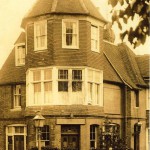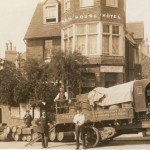By John Hodges
Sometime after 1066 the first Norman Castle in England, constructed in stone, was built on what is now known as the West Hill. The original construction was of wood and it was not till some years later that the stone remains of that crumbling edifice that we know today as Hastings Castle came into being.For several centuries the Castle was the only building of note on the West Hill, the rest of the area being divided into fields whose names such as the Coney banks bear witness to their respective usage. By the turn of the 15th Century the Castle had its first neighbour of note when John Salerne of Winchelsea had built what is probably the town’s first windmill on a site topographically ideal for converting the winds of nature into renewable energy, a truly green pioneer.
By the middle of the seventeenth century both the East and West Hills were regarded as common land. However, by around 1750 parts of the land on both of these hills had come into the ownership of John Collier and this was recorded as such on the map produced by the schoolmaster Samuel Cant. By 1785 it was also recorded that Mr John French had ownership of a mill on the West Hill which was subsequently very badly damaged in a storm around 1809. Probably the next significant occurrence in this area was the opening in 1827 of the St.Clement’s Caves by John Golding a local greengrocer, who extended those that had previously existed. The original Caves, some of which were natural, had probably been created over many years by the extraction of sand used not only in construction but also in the process of glass making. Rumours of smugglers tunnels were legion, and subsequent investigations certainly confirmed that they continued westward towards the other side of the West Hill. By the middle of the nineteenth century one of the existing windmills had been transferred to Silverhill, whilst the area could now boast the addition of a steam driven flour mill.
As the population of Hastings increased so did the need for food and by about 1870 no less than three windmills existed on the West Hill plus the further steam mill which stood at what is now the junction of Priory Road and Gordon Road. The middle of the 19th Century signalled the peak of the agricultural activity in this area but the demands of the expanding “new” Hastings in the Priory Valley for building land soon proved too great for the entrepreneurial land owners of the West Hill. In 1873 the first steam mill was demolished quickly followed the next year by the mill and granary in Plynlimmon Terrace. December 4th, 1874 saw the last of the West Hills windmills and by about 1880 the whole area had been developed into an urban suburb of Hastings. Certainly the development of the West Hill, including the estate that was built in the garden of Castledown House, was almost complete by the turn of the nineteenth century.
Among the buildings that sprang up were several Hotels and Public Houses, perhaps the most unusual in design being the Red House still standing today as a private house in Emmanual Road. The Red House was built during 1875 almost certainly as a hotel and it first opened its doors to the new residents of the West Hill in the following year. The original owners were J.C. Burfield and Company of the Phoenix Brewery in Courthouse Street, a small local Brewer with several pubs in this area of Hastings. One can imagine the enormity of the drayman’s task in those days of the late 19th Century, when the access to the West Hill from the Brewery in the Old Town was by the tortuous route over the old Coney banks with probably no more than two in hand as motive power. However, Burfields retained ownership of the Red House only until 1908 when they were bought out by Smith and Company of Lamberhurst. In 1921 P. Allen Simpson the managing director of Smiths decided to retire and devote himself to farming, and this necessitated all of their sixty eight properties being offered for sale by auction in one lot. Unfortunately this offer failed to realise its reserve and a decision to sell the tied estate off in single lots was more successful, with just fourteen lots remaining unsold. One of these properties was the Red House which found its way into the ownership of the Kemp Town Brewery of Brighton where it remained until its ultimate demise.
The Phoenix Brewery, owned by Burfields the original owners of the Red House, together with the adjoining Ship-Wrights Arms was also lost to the town as a Brewery when in 1912 it was sold by Smiths together with the land that adjoined the Red House at an Auction held in the Castle Hotel. As we know the Red House survived as a Pub for another forty years until the Brewster Sessions of 1951 wanted to declare it redundant. The Landlord at that time was an old Boer War Veteran by the name of William Gardner who attended court, literally on his sick bed, to plead the case for his license. This was all to no avail and on October 18th 1951 the Red House finally closed as a Public House. Over the years this public house had served the local community in many ways, it provided a home for a harmonic society and a benefit society whilst the local politicians of both persuasions of the day have enjoyed its hospitality in the pursuit of the support that would give credence to their respective policies. But the old Red House still stands to this day, despite the best attempts to obliterate it by enemy action owing to its proximity to the prominent landmark of Emmanuel Church, it remains as a reminder of the story of the West Hills evolution from rural agriculture to a solid urban suburb of the new Hastings.
First Published in “Rye’s Own” November 2015
All articles, photographs, films and drawings on this web site are World Copyright Protected. No reproduction for publication without prior arrangement. (Hard Copy Back Numbers Still Available) © World Copyright 2017 Cinque Ports Magazines Rye Ltd., Guinea Hall Lodge Sellindge TN25 6EG
